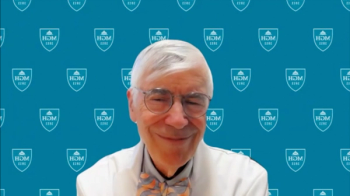
Researchers Assess ICI Resistance in Melanoma Treatment
Researchers outline factors that may inhibit immune checkpoint inhibitor efficacy in patients with melanoma.
In a review published in
Although melanoma is generally uncommon, it has a poor survival rate and incidence is increasing worldwide with age—it is mostly diagnosed in individuals between ages 70 and 80. For the most favorable outcomes, early diagnosis is crucial, authors wrote, noting that in those with metastatic disease, less than 10% completely recover.
“Melanoma responds poorly to chemotherapy and interferon therapy, but relatively recent findings on melanoma biology at the molecular level have resulted in the development of new treatment options: ICIs and targeted therapeutics,” they explained.
As patients were previously limited to treatment with chemotherapy and dacarbazine, the introduction of ICIs to melanoma has been “revolutionary,” despite combination ICIs sometimes resulting in high toxicity among patients. Furthermore, one study found that “in almost one-third of patients with metastatic melanoma who initially responded to ICI therapy, there was melanoma progression within 3 years,” the researchers said.
Ipilimumab, a monoclonal antibody to immune checkpoint cytotoxic T-lymphocyte–associated protein 4 (CTLA-4), was the first ICI approved for advanced melanoma. CTLA-4 activation plays a role in T-cell suppression and acts as a T-cell inhibitor, thus promoting apoptosis. T regulatory (Treg) cells also sustain tolerance by using CTLA-4 to suppress effector T cells.
“Although ipilimumab antitumor effects are not completely understood, it was found that the CTLA-4 blockade enables enhanced T-cell priming by more efficient antigen presentation and reduced Treg function, all of which leads to more abundant effector T-cell infiltration in the tumor microenvironment (TME),” the authors explained.
Programmed cell death protein 1 (PD-1), a second checkpoint protein, also contributes to self-tolerance but becomes expressed in the effector phase of the immune reaction, unlike CTLA-4. Nivolumab and pembrolizumab mark 2 anti–PD-1 axis monoclonal antibodies approved for melanoma treatment.
Both the mutational load in malignant cells and expression of major histocompatibility complex (MHC) molecules on their surface can be predictive of a good response to ICI.
“Primary resistance to PD-1–based immunotherapy manifests in 40% to 65% and with ipilimumab therapy in more than 70% of melanoma patients,” the researchers said. Tumor mutational burden (TMB) and tumor immunogenicity can affect the first step in the cancer immune cycle, while T-cell migration through the endothelium and tumor niche infiltration can be affected in the last phase. Several mechanisms can also attenuate T-cell toxicity, which may result in uncontrolled malignant cell proliferation.
“An immunosuppressed environment results in escape mechanisms for malignant cells, enabling tumor progression. Given that currently available ICIs reverse the tumor inhibitory signals toward effector T cells, all the factors that dampen T cells at any stage of the antitumor immune response cause ICI therapy to be less effective,” the authors wrote.
Despite one study showing TMB was positively correlated with overall survival in patients treated with ICIs, and another finding higher TMB was a positive prognostic factor across different tumor types treated with ICIs, the researchers cautioned other studies imply it is not a unique predictive biomarker of ICI efficacy across tumor types.
Another potential route for ICI resistance concerns dendritic cells (DC). “It was observed, for instance, that lipid accumulation in DC leads to their attenuated response to tumor antigens,” the authors explained, adding that “any factor that impairs DC maturation or function also contributed to resistance to ICIs.”
Additional factors that could contribute to primary resistance mechanisms of ICIs include T-cell trafficking and TME infiltration, immunosuppressive TME, and the composition of the gut microbiome.
When it comes to acquired resistance, which develops after a period of clinical response to treatment following which the tumor progression occurs, changes that lead to this event can take place at the cell-population or single-cell levels.
According to the researchers, deficient antigen presentation contributes to acquired ICI resistance. Specifically, as “loss of beta 2 microglobulin (B2M), a component of MHC class I molecules which is involved in priming of CD8+ cells, results in an impaired process of regulation of cytotoxic T lymphocytes (CTL). It has been observed that B2M mutations associated with the loss of MHC I expression are present in patients who developed acquired resistance to ICIs.”
The Janus kinase 1 and 2/signal transducer and activator of transcription (JAK 1, 2/STAT) signaling pathway, the lymphocyte activation gene 3 expressed on the T-cell surface, and the T-cell immunoglobulin and mucin domain 3 have also been implicated in acquired resistance to ICIs.
As far as developments for therapeutic strategies for melanoma, the authors propose simultaneous inhibition of 2 or more immune checkpoints as the logical next step. Additional options include the combination of radiotherapy and PD-1/programmed death-ligand 1 inhibitor therapy or modification of the gut microbiome.
“Recently, a published clinical study reported success in reverting anti–PD-1 resistance in 6 out of 15 patients to whom respondent fecal microbiota transplantation was performed, linking the change in gut microbiota with response to anti–PD-1 therapy,” the researchers said.
New immune checkpoints are also being explored for melanoma treatment, although the hurdle of avoiding severe toxicity resulting from drug combinations presents a challenge.
Overall, “we can see that despite the revolution that [immune checkpoint inhibition] has caused for melanoma patients, successful treatment still faces a long road ahead,” the authors concluded. “A combination of current and future drugs targeting different resistance mechanisms seems like a reasonable solution, but agents with lesser toxic effects are still needed.”
Reference
Vukadin S, Khaznadar F, Kizivat T, Vcev A, Smolic M. Molecular mechanisms of resistance to immune checkpoint inhibitors in melanoma treatment: an update. Biomedicines. Published online July 18, 2021. doi:10.3390/biomedicines9070835
Newsletter
Stay ahead of policy, cost, and value—subscribe to AJMC for expert insights at the intersection of clinical care and health economics.





























































